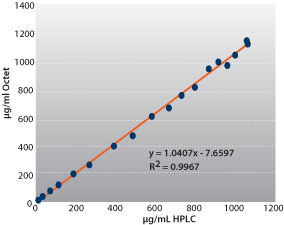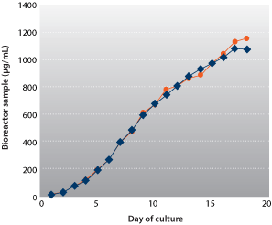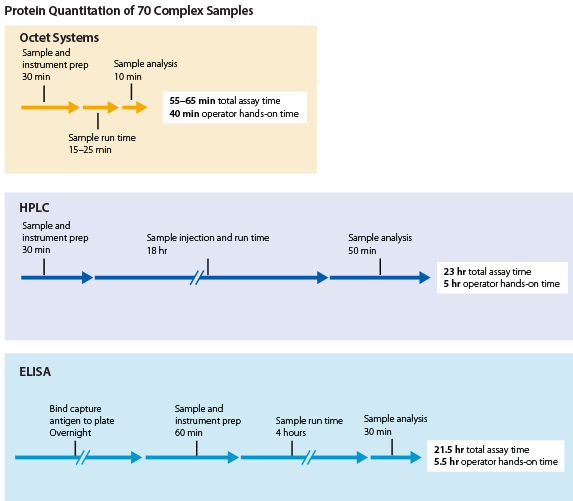ForteBio's Octet® family of instruments provides rapid and accurate analysis of antibody and other protein concentrations. Its analytical capabilities provide particular value in applications where existing methods such as HPLC and ELISA have limitations in throughput, performance, workflow, and ease of use.

Figure 1: Octet QK correlation with HPLC.

Figure 2: Bioreactor process time profile of cell culture supernatants.
Octet instruments provide label-free quantitation of antibodies or other proteins that are critical to:
- Early cell culture screening
- Protein purification
- Cell line selection for optimization of antibody and therapeutic protein production
- Biologicals manufacturing monitoring
With full-plate quantitation of IgG samples in as little as two minutes, Octet instruments are easily used to rapidly screen and quantitate therapeutics recombinant proteins with great accuracy. Moreover, the recombinant therapeutic proteins can be quantitated in their cell culture media, allowing for the efficient and rapid optimization of growth media conditions.
Figure 3: Quantitation of recombinant Factor VIII in different media using the high precision Streptavidin biosensors (SAX) on Octet instruments.
Key Benefits
- Fast and high throughput quantitation
- Specific quantitation in crude matrices
- Quantitation is done in real time
- Wider dynamic range than ELISA
- Expensive samples can be recovered
- Cost savings through biosensor surface regeneration
Accurate antibody and recombinant protein quantitation is critical to the selection of cell lines for development and for the optimization of bioreactor titers in production. Traditional measurement methods include ELISA, HPLC, nephelometry, and densitometry. Drawbacks to these methods include long analysis times, lack of specificity, labor-intensive protocols, and variable imprecision. The BLI-based Octet family of instruments supports each step of bioprocessing, streamlining and speeding your workflow.

Figure 4: Comparison of time versus speed involved in protein quantitation using the Octet method and alternative methods.
The Octet family of instruments provides a complete on-demand, label-free solution for both antibody and recombinant protein quantitation. While HPLC monitors total protein content, the Octet systems monitor specific analyte concentrations and even though both techniques have comparable quantitation dynamic range for a generic IgG molecule, Octet systems have 10-fold lower limit of detection (LOD) and 20-fold lower limit of quantitation (LOQ) than HPLC. In addition, Octet HTX and 384 instruments can be integrated to automation platforms to allow for quick screens for expression levels in cell lines under different growth media conditions hence significantly reducing cell line development time resulting into faster development of therapeutic protein drugs.
Off-the shelf biosensors offered for protein quantitation include:
There are also a host of other ready to use biosensors for quantitation of a variety of IgG isotypes or recombinant proteins. The high-precision Streptavidin-coated (SAX) biosensors expand your quantitation options to include all proteins in developing custom protein assays that are easier to process than ELISAs, while still providing rapid and accurate results.
Application and Technical Notes
Webinars
More Information